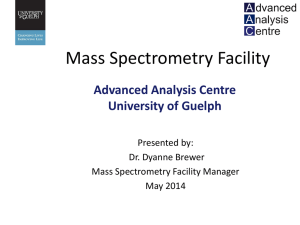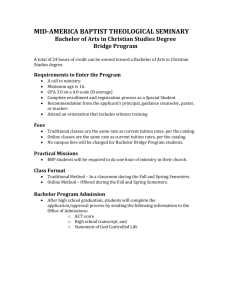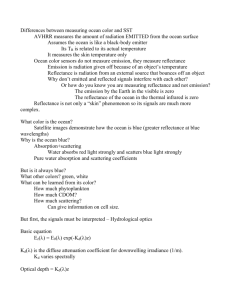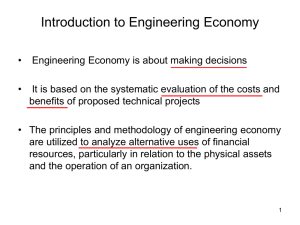BBP_Software_Impl_v19 - University of Southern California
advertisement
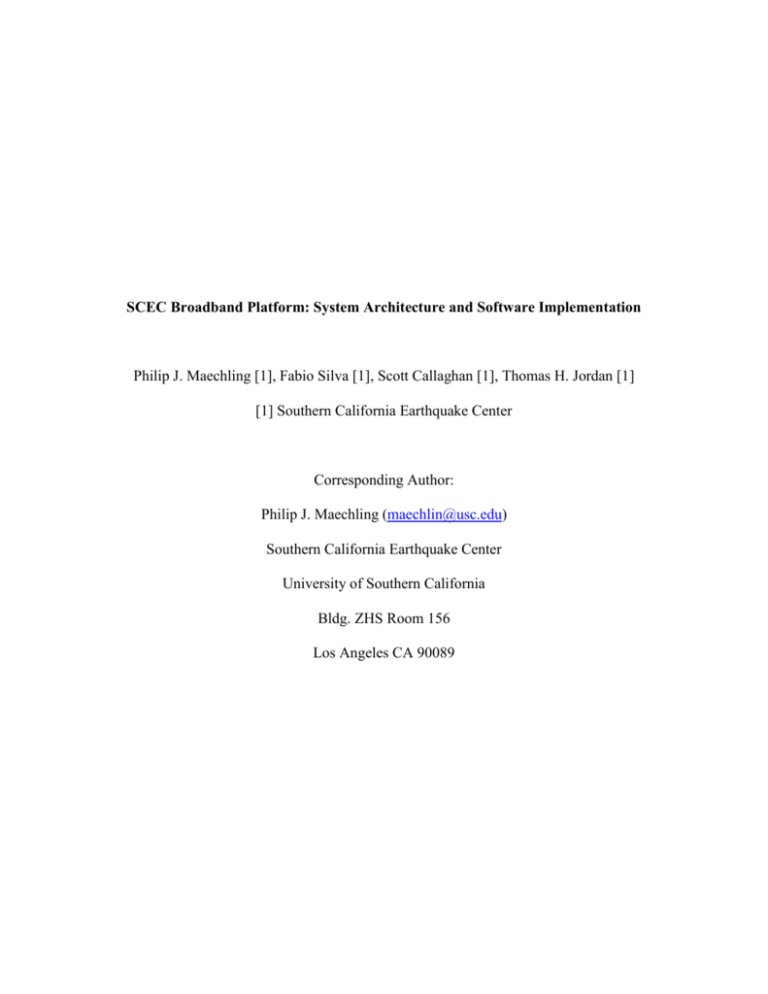
SCEC Broadband Platform: System Architecture and Software Implementation Philip J. Maechling [1], Fabio Silva [1], Scott Callaghan [1], Thomas H. Jordan [1] [1] Southern California Earthquake Center Corresponding Author: Philip J. Maechling (maechlin@usc.edu) Southern California Earthquake Center University of Southern California Bldg. ZHS Room 156 Los Angeles CA 90089 Introduction The SCEC Broadband Platform (BBP) is an open-source software distribution that contains physics-based ground motion models capable of calculating earthquake ground motions at frequencies above 10Hz across regional distances. In addition, the BBP contains software tools for evaluating ground motion models and comparing simulation results against observed ground motion recordings and against ground motion prediction equations (GMPEs). The BBP also includes software utilities that help users run large numbers of ground motion simulations and manage the simulation results. Several of the ground motion simulation methods included in the BBP are described in related articles in this special focus issue. In this article, we describe how the BBP system architecture and software implementation support the scientific and engineering processes needed to assess ground motion models for use in engineering applications. BBP System and Software Requirements The BBP design and development was initiated after a number of promising broadband ground motion simulation methods were developed. Researchers were interested in comparing ground motion simulation results between methods, and in comparing simulation results to observations. Such comparisons can be difficult because alternative methods often require different input parameters, or specify input parameters in dissimilar formats. Fair comparisons between methods are only possible once multiple methods can input the same problem definition and output comparable results. Based on previous experience evaluating simulation methods, seismologists and earthquake engineers recognized a need for a software tool to support the 2 evaluation of the newly emerging broadband simulation methods. Drawing on discussions with both seismologists and engineers, we identified the following list of essential capabilities of the required tool. The BBP should: Implement multiple ground motion simulation methods capable of outputting ground motion seismograms. Enable each ground motion method to run exactly the same problems and produce directly comparable results. Produce repeatable results. Be extensible, so that ground motion simulation methods can easily be added or modified. Provide seismogram post-processing methods to support analysis of simulation results. Be extensible, so that post-processing methods can easily be added or modified. Run in broadly available, inexpensive, computing environments based on the Linux operating system. Use open-source software tools, such as the GNU compilers, available for use by academic research communities. Version software distributions so simulation results can be attributed to a specific software version. Be released as open-source scientific software. The goals of the SWUS and NGA-E projects described in this special focus issue added additional BBP requirements. For SWUS and NGA-E, it was important that the BBP should: Separate common input parameters, such as the source description and velocity model used by all methods, from method specific parameters used by individual methods. 3 Allow each method to define region specific configuration parameters, and provide tools to determine which configuration parameters work best for a given validation event. Support comparison of simulated ground motion amplitudes to observed ground motion amplitudes. Support comparison of simulated ground motion amplitudes to ground motion amplitude ranges given by existing GMPEs. Support large suites of scenario ground motion simulations as needed in evaluation processes by running many simulations quickly using high-performance computers. Support collaborative scientific and engineering ground motion simulation evaluation processes. In the remainder of this article, we describe how we designed and implemented the BBP to meet these user requirements. These user-oriented software requirements helped us prioritize BBP software development, and as a result, the BBP has developed into a system capable of supporting the scientific and engineering ground motion simulation evaluation processes described elsewhere in this issue. Broadband Platform Concepts and Terminology A set of concepts and related terminology has developed around the BBP. These terms, once defined, make communications about the platform easier. To begin, we describe the BBP as a platform, to communicate the fact that it is more than a single scientific application program. In SCEC terminology, a computational platform is a well-integrated collection of validated scientific software and geophysical models that can perform a useful research calculation. The BBP implements a component-based software architecture. Within the BBP, a component is a 4 scientific program that has been integrated into the platform, accepts BBP format inputs, and produces BBP format outputs. A method is a collection of one or more components that can perform a ground motion simulation. Workflows, or pipelines, are equivalent concepts that refer to a sequence of processing that may include both ground motion simulations and validation processing, in which the output of one component is used as input to the next processing stage. A simulation is the basic unit of work for the BBP. A simulation represents an invocation of the platform using a specific source description, site list, velocity model, and method, that produces one, or more, output seismograms. Practical use of the BBP typically requires running many simulations. A scenario is a problem specification with a specific fault geometry, earthquake magnitude, earthquake mechanism, and site list. A realization is a specific instance of a scenario that may differ from other realizations by hypocenter location, or slip distribution. In BBP usage, verification involves comparison against expected results, while validation involves comparison against observations. Figure 1 shows an example of a BBP validation workflow to illustrate the concepts we are presenting. Armed with these concepts, we can more easily describe the capabilities of the current BBP system. Data Flow Processing Model with File-based Data Exchange Formats The BBP was constructed by integrating a collection of independently developed scientific software programs. The availability of these existing open-source scientific codes led to a modularized BBP system architecture, that separate BBP processing into multiple small stages. By assembling the BBP from multiple software programs, we avoid a monolithic software program that is difficult to understand and modify. However, with this modular approach, multiple software programs must be used to implement a basic BBP ground motion calculation, and most of the independently developed scientific codes used in the BBP were not 5 developed with interoperability in mind. Our basic approach for making the BBP codes interoperable is to define a BBP calculation as a well-defined sequence of programs in which files output by one processing stage are used as inputs by subsequent processing stages. BBP developers describe this as a dataflow architecture with file-based data dependencies. BBP users may refer to this as a workflow or pipeline processing approach. As mentioned above, the BBP uses file-based data exchange between processing stages. File-based communication between programs is slower than several other possible approaches, but it is easily implemented and it reduces the need to modify the components involved. The BBP defines standard text-based file formats as interfaces between components. BBP components are configured to read files in BBP format, and to output results in BBP file format. Note that, internally, components can use their own input and output formats, and they may use method-specific input files such as Greens Functions, but they must convert their internal formats to BBP formats at component interfaces. This format conversion approach works as long as native file formats contain the information required by the BBP standard format. Examples of standard BBP file formats are included in the electronic supplement. A list of standard BBP exchange formats is provided below: SRC - A source file contains simple rectangular fault geometry, an earthquake magnitude, and a hypocenter location. Site list - A site list contains a list of one, or more, sites for which ground motions will be calculated. Both the site list and the SRC file contain geographical locations, and the relationship between the SRC hypocenter location and the site locations determine the distance from the event to the site of interest. 6 Velocity model - A velocity model file contains a list of velocity layers assumed to be in the geographical regions. For methods that use Greens Functions (GFs), the input 1D velocity model must match the 1D velocity model used to generate the GFs. SRF - A rupture generator component converts a simple SRC file into a standard rupture format (SRF) file based on seismological rules implemented in the rupture generator. The SRF format describes the earthquake source in a time series format. There are no time parameters in the SRC file source description. BBP seismograms - The BBP outputs ground motion seismograms in a three-component time series format. BBP seismogram timestamps are given relative to event origin time, not arrival time or absolute time as found in most observational data formats. The BBP seismogram format is used to represent multiple ground motion types including acceleration, velocity, and displacement. BBP seismogram format is used as the standard input and output format for BBP methods and utilities. In addition to these BBP exchange formats just described, there are two more standard file formats used within the BBP. These two text formats are important to the operation of the BBP platform, but they are not, strictly speaking, data exchange formats. XML workflow - The BBP defines each simulation in an XML format that defines the components that will be used, and the input files to be used in each stage. The BBP XML format defines a directed acyclic graph, a common workflow definition form. Observational ground motion time series data - BBP validation processing requires management of observational data sets. The BBP can store observed ground motion seismograms in PEER seismogram format, or alternatively, in BBP seismogram format. 7 The BBP implements its multi-stage computing capabilities using two important software constructs. First, the BBP defines an XML workflow specification format to describe the input files and computer programs needed to run a ground motion simulation and any required postprocessing stages. Second, the BBP provides a software framework that interprets these XML workflow specifications and executes the given list of programs, with the given input files, in the correct order. With these two capabilities, the BBP can flexibly support multi-stage ground motion simulation calculations, making it easy to add or remove computational stages without changes to the BBP infrastructure. BBP XML files are important metadata because they define the exact inputs and programs used to calculate a particular result. Given a working copy of the BBP software, and the required input files, a BBP XML workflow specification can be used to re-run a specific BBP ground motion simulation. The number and type of processing stages in a particular BBP simulation depends on the specific user-defined research calculation defined in the XML file. Figure 2 shows the data inputs and processing components defined in a BBP XML workflow specification needed to implement the BBP workflow in Figure 1. Scientific Software Components The BBP performs its processing by running a series of BBP components. Each component accepts file-based inputs in one of the BBP standard formats, and outputs results in one of the BBP standard formats. Typically, a component is implemented as a Python language program. An example BBP component is shown in Figure 3. In many cases, a BBP Python language component calls a software executable written in a compiled programming language, such as C or Fortran, in which case, we call the Python program a wrapper. Python wrappers are an important design technique used to build the platform. By constructing each component as a Python language program, the 8 overall BBP framework calls only Python programs, hiding the use of other programming languages and executables. Wrappers enable us to integrate programs in a variety of languages into the platform with a minimum of modifications. To reduce the modifications to the scientific program, component wrappers often perform file format conversion processing, converting BBP format inputs to the native input format of the scientific codes, then converting the native output format of the scientific code to BBP format before the component processing completes. In this way, minimum modifications to the original scientific codes are required. Within the platform, we distinguish between BBP components used to implement ground motion simulation methods, and BBP components used to implement common post-processing stages. Examples of BBP components used to implement ground motion methods include rupture generators, low frequency deterministic waveform processing, and high frequency stochastic components. As described earlier, a method may be implemented by combining components from different sources. For example the Graves & Pitarka (GP) low frequency ground motion simulation component is used in both the GP method (Graves and Pitarka, 2010), when combined with the GP stochastic high frequency component, and in the SDSU method (Mai et al, 2010), when combined with the SDSU stochastic high frequency component. All BBP methods produce output seismograms. In some BBP uses, such as scenario simulations, seismograms are the desired end product. However, if additional post-processing is desired, the BBP provides a set of common post-processing tools, and the same post-processing methods are used regardless of the ground motion simulation methods involved. Currently, the BBP provides common post-processing components that can integrate and differentiate time series, components that can calculate amplitude values such as peak acceleration, spectral acceleration at various periods, and specialized ground motion amplitudes such as ROTD50. A 9 summary of current BBP ground motion simulation methods, showing the components used to implement each method, and two common post-processing components is shown in Table 1. Table 1: Table columns describe three ground motion simulation stages and two common postprocessing stages. Table rows show how selected BBP simulation methods are implemented in one or more processing stages within the Broadband Platform and how the common postprocessing programs are used to analyze results from all simulation methods. GroundMotion Goodness Ground Motion Rupture 0 to 1Hz 1 to 100Hz Post- of Fit Post- Model Generator Motions Motions Processing Processing GP (Graves and Gen_Slip JB_Sim HF_Sim Pitarka) SDSU Gen_Slip JB_Sim BB_Toolbo UCSB UCRMG RotD50 Bias Plot Syn1D x EXSIM EXSIM CSM: Composite Simula Source Model Several BBP methods make use of random numbers, as they model stochastic processes. Use of random numbers can lead to problems producing reproducible results. To support both use of random numbers and reproducible results, the BBP makes use of a random number generator seed defined in the BBP standard input SRC file. As long as the same seed is used, the random number generator used by the BBP will produce the same sequence of random numbers. Currently within the platform, random seeds are used to randomize the slip distribution in the rupture generators, and to seed the scattering wavelets calculation in the SDSU high-frequency component. 10 BBP Data Products Users can view the BBP as a software black box that inputs configuration files, consumes computer-processing time, and outputs file-based data products. The file-based data products produced by the BBP vary depending on the type of simulation the user performs. When a user runs a BBP simulation, the BBP assigns a unique Simulation ID (or SimID) to the simulation, and creates a data directory using that SimID to organize the inputs, temporary files, and outputs produced by that simulation. Output data products for a simulation are found in the output data directory when the simulation run completes. Organizing results into simulation-specific directories separates results from different simulations, and ensures that results from one simulation do not overwrite the results from a previous simulation. We can categorize output BBP data products into two types: standard data products, and comparison data products. Standard BBP format output data products can be produced for both validation and scenario simulations, and some standard output products are optional and user selectable. Standard BBP output data products include seismogram files in BBP format, seismogram plots in PNG format, SRF slip plots, spectral response plots, and fault and station maps. Comparison data products are produced when the platform is used in validation mode. In this case, the platform will produce the standard data products, as well as data files and plots that compare simulation results against observed data. Comparison data products include seismogram comparison plots, Goodness of Fit (GOF) bias plots, and GMPE comparison plots. Examples of BBP data products for scenario simulations are shown in Figure 4. Figure 5 displays BBP data products for validation simulations, and Figure 6 shows Goodness-of-Fit (GoF) data products that the BBP can produce for validation simulations. 11 Broadband Distribution and Installation SCEC distributes the BBP as a collection of C and Fortran language source codes, Python scripts, configuration files, Green’s functions data files, test cases, and observational data files. The BBP platform uses an open source software policy to provide transparency into the scientific codes, ensuring that users can review, and test, any of the methods or software utilities used. The target development and runtime environment for the BBP is a 64-bit Linux computing environment with the GNU compiler and tools. Many of the scientific codes used within the BBP must be compiled before the platform can be used. When SCEC releases a new BBP distribution, users can retrieve the new distribution from the BBP web site, install the platform on their Linux computer, configure the installation properly, build the executables, and test the new installation before using it for research purposes. Currently, new releases of the BBP are distributed in multiple separate tar files that we call packages. We have separated the BBP into multiple packages because the size of all packages combined exceeds 8GB, and because not every BBP user needs all the packages. The BBP source code package that contains the main Broadband Platform files including the scientific codes, method-specific data and configuration files, plotting utilities, and testing codes used to ensure the Broadband Platform is properly installed and generating expected results. Along with the source code packages, users need to install at least one velocity model package. The BBP v14.3 distribution includes one velocity model package for each of the supported regions, which currently include: LA Basin, Mojave, Northern California, Western Japan, Central Japan, Eastern United States, and Eastern Canada. In addition to the standard BBP format velocity model file defined for the region, each of these packages includes Greens' Functions for the GP (Graves and Pitarka, 2010) and the UCSB (Schmedes et al, 2010) methods, 12 region-specific files required by other methods, such as ExSIM (Atkinson et al, 2009, and Motazedian et al, 2005) and CSM (Zeng et al, 1994), and a configuration file that lists all regionspecific parameters for each of the scientific methods. Since velocity model packages are large, around 1-2GB each, each region is distributed separately, allowing users to download and install only the packages they need. BBP users need to install validation packages only if they want to run validation simulations. Validation packages contain carefully selected observational data recorded for the earthquake being studied. Each BBP validation package is distributed separately so users only need to download the validation events of interest. The full procedure for installing a BBP distribution is described in the BBP users manual, available on the SCEC BBP website. Once the required set of BBP files are installed, the BBP platform uses two types of automated software test suites, called Unit Tests, and Acceptance Tests, to ensure the platform is working correctly before is it used in a research calculation. When the Unit Test suite passes, it confirms that the BBP has been installed correctly, and that individual components are producing the same results on the deployment computer as they produced on the development systems at SCEC. When the BBP Acceptance Tests pass, it shows that, at a minimum, the platform has run one end-to-end earthquake simulation using each method, and each method produces ground motion amplitudes that match the development system results within acceptable tolerance established by scientific and engineering users at the time the code was released. We assign version numbers to SCEC software using a date-based versioning scheme with a Year.Month.RevisionNumber format. So, BBP v13.6.0 is a version of the BBP software released in June 2013. BBP v13.6.1 is the first revision of the v13.6.0 release. Each BBP distribution package (source code package, velocity model package, and validation package) has its own separate version number. This allows us to update individual packages without having to 13 re-release the entire set of files every time a modification is made. The BBP source file package version number identifies the official BBP version, such as v13.9.0 or v14.3.0. In some cases, we associate a version of the Broadband Platform with a validation and review exercises. For example, the BBP v13.6.1 release was used in the 2013 SWUS validation exercise, and the BBP v14.3.0 release was used in the NGA-East validations exercise (Dreger et al, 2014). In general, we recommend researchers use the most recent public release of the BBP software because the ground motion models and computational infrastructure continue to improve rapidly. In some cases, however, users may want to reproduce results from versions of the platform that have been reviewed by an evaluation panel. SCEC maintains an archive of previously released versions of the BBP platform to support such usage. Running the BBP Once the platform is installed and running correctly, a BBP user can configure and run a ground motion simulation through a text-based interface that presents the user with a series of questions, and creates a BBP workflow based on the user’s responses. Once created, the user can run the workflow immediately, or save the workflow as an XML file, which can then be used to run the calculation repeatedly without re-specifying the workflow. The BBP software is designed to separate the command line user interface, used to construct the workflow, from the workflow flow engine that runs the processing sequence defined in the XML workflow. The following example command line shows how a user can run a BBP simulation that will execute the processing sequence defined in a specific BBP XML workflow file. $ run_bbp.py -x northpalmsprings-gp-0000.xml Currently all the programs in the BBP are single-threaded, serial programs that run on 64bit x86 computers. The platform has been run successfully on computing clusters, such as the 14 USC High Performance Computing and Communication (HPCC) cluster. In this case, the platform uses each core within a node on a cluster as a serial processor, running a different simulation on each core. BBP Development Areas and Planned Improvements From the software development perspective, close collaboration with scientific and engineering users has greatly improved the capabilities of the BBP, making the software development more efficient, and helping to prioritize the software development tasks, so future BBP development will be driven by the needs of the emerging BBP user community. In the following sections, we describe several-planned BBP improvements based on recent discussions with the scientific and engineering groups involved in current BBP development. New ground motion models are under development, and existing models continue to improve, so we expect to integrate new ground motion simulation components into the BBP, including alternative rupture generators, and new ground motion simulation methods that perform all processing stages. Computational methods that include non-linear site response processing stages are also under development. We also expect to add additional validation events into the platform. Adding a new validation event to the BBP typically involves developing scientific consensus on how to parameterize the source description, how to define the 1D velocity model, and on the selection of ground motion observations to be used in GOF evaluations. Engineering users would like simulation methods within the BBP to model multisegment ruptures, which are often needed to simulate very large earthquakes. Scientists and engineering continue to develop and refine evaluation procedures for engineering use of ground motion simulations, so we expect additional post-processing and goodness of fit methods will be 15 required in the future. Several existing BBP methods depend on pre-calculated Greens Functions, defined for specific 1D velocity models, and BBP simulations are currently limited to using these predefined, provided, 1D models. We plan to remove this limitation by integrating code into the BBP that can calculate GF for arbitrary 1D models. At some point in the future, the BBP may be modified so it can make use of 3D low frequency seismograms, rather than the current 1D low frequency seismograms. However, 3D simulations require high performance computers (HPC). So, initial BBP support for 3D simulations is likely to be based on importing externally calculated 3D seismograms, rather than on integrating 3D HPC simulation codes into the platform. We have identified several software engineering improvements that we believe will improve the BBP user experience. We would like to develop a more flexible interface for constructing workflows, to improve upon the current command line interface. We will continue to refine and improve the standard BBP data exchange file formats, to improve their usability, so future revisions of these formats should be expected. The current BBP software distribution is complex and we are looking for ways to make it easier for users to install and run the BBP in their own computing environment. We want to help users contribute new methods by clearly defining the required input parameters and providing example results. We would like to document the individual components within the platform. We would like to establish persistent, searchable, data archive of BBP releases and associated evaluation results, providing researchers with standard reference problems that can be used to evaluate new ground motion simulation methods under development. 16 Conclusions The SWUS and NGA-E ground motion simulation evaluation processes show that the BBP successfully enables a neutral third party, to run multiple, complex simulation methods, using a specific software version for each code, processing results from all methods using a common suite of post-processing algorithms for the generation of statistics and plots. The BBP combines ground motion modeling capabilities with the tools needed to perform comparison of ground motion simulation results to alternative simulation methods, to observed seismograms, and to ground motion prediction equations. The SCEC BBP software allows users to run simulations without detailed knowledge of how a particular method is implemented, making it possible for non-scientists, and third parties, to run ground motion simulation models and produce useful results. The BBP also provides a working implementation of ground motion simulation evaluation processes defined by seismologists and earthquake engineers to qualify ground motion simulations for engineering use. Acknowledgments The authors would like to thank the Broadband Platform Validation Group for valuable direction and feedback on BBP software development, keeping the Platform relevant to scientific and engineering needs. We would like to thank NSF for supporting BBP development through NSF Award OCI-1148493, A Sustainable Community Software Framework for Petascale Earthquake Modeling. We would also like to thank the Pacific Gas and Electric Company for its support to the SCEC Broadband Platform development. Finally, the authors would like to thank the USC HPC team for their support running our simulations on the USC cluster. 17 References Boore, D. M. and G. M. Atkinson (2008). Ground-motion prediction equations for the average horizontal component of PGA, PGV, and 5%-damped PSA at spectral periods between 0.01 s and 10.0 s, Earthquake Spectra 24, 99-138. Abrahamson, N. A., and W. J. Silva (2008), Summary of the Abrahamson & Silva NGA GroundMotion Relations, Earthquake Spectra, 24(1), 67-97. Campbell, K. W. and Y. Bozorgnia (2008), NGA ground motion model for the geometric mean horizontal component of PGA, PGV, PGD and 5% damped linear elastic response spectra for periods ranging from 0.01 to 10s, Earthquake Spectra, 24(1), 139-171. Chiou, B. S.-J. and R. R. Youngs (2008), An NGA model for the average horizontal component of peak ground motion and response spectra, Earthquake Spectra, 24(1), 173-215. Graves, R. W. and A. Pitarka (2010). “Broadband Ground-Motion Simulation Using a Hybrid Approach.” Bulletin of the Seismological Society America, 100(5A), pp. 2095-2123, doi: 10.1785/0120100057 Mai, P.M., W. Imperatori, and K.B. Olsen (2010). “Hybrid broadband ground motion simulations: combining long-period deterministic synthetics with high frequency multiple S-to-S 18 back-scattering.” Bulletin of the Seismological Society America, 100(5A), pp. 2124-2142, doi: 10.1785/0120080194 Schmedes, J., R. J. Archuleta, and D. Lavallée (2010). “Correlation of earthquake source parameters inferred from dynamic rupture simulations.” J. Geophys. Res., 115, B03304, doi: 10.1029/2009JB006689 Zeng, Y., J. G. Anderson, and G. Yu (1994). “A composite source model for computing realistic synthetic strong ground motions.” Geophysical Research Letters, 21(8), pp. 725-728, doi: 10.1029/94GL00367 Atkinson, G. M., D. M. Boore, K. Assatourians, K. Campbell and D. Motazedian (2009). “A guide to differences between stochastic point-source and stochastic finite-fault simulations”, Bulletin of the Seismological Society America 99, 3192-3201 Motazedian, D., and G. M. Atkinson (2005). “Stochastic finite-fault modeling based on a dynamic corner frequency”, Bulletin of the Seismological Society of America 95, 995-1010. Dreger, D. S., G. C. Beroza, S. M. Day, C. A. Goulet, T. H. Jordan, P. A. Spudich, and J. P. Stewart (2014). “Evaluation of SCEC Broadband Platform Phase 1 Ground Motion Simulation Results”, Seismol. Res. Letters (in preparation). 19 Goulet, C. A. and Abrahamson, N. A. (2014). “The SCEC Broadband Platform validation exercise: methodology for code validation in the context of seismic hazard analyses”, Seismol. Res. Letters (in preparation). Figure Captions: Figures 1: A BBP simulation workflow with a ground motion simulation method implemented using three components and two stages of post processing. This ground motion simulation method shown is a three-component method that uses a rupture generator, a low frequency ground motion simulation, and a high frequency ground motion simulation. Optional postprocessing calculations are shown. Ground motion time series are converted to amplitude. Validation processing compares simulation results against observed ground motions. Figure 2: DAG representatioin of a BBP workflow Figure 3: BBP component implemented with Python wrapper of compiled scientific codes. 20 [Figure 2] BBP scenario simulations produce ground motion time series data, along with a map of stations and a slip plot. [Figure 3] BBP validation simulations produce time series and PSA comparison plots that compare simulation results against observed historical earthquakes. [Figure 4] Goodness-of-Fit (GoF) plots generated by the BBP, comparing simulation results against recorded data. The Platform generates GoF by period, distance, and location. Additionally, the Platform can plot results from the NGA-08 models against recorded data. 21
